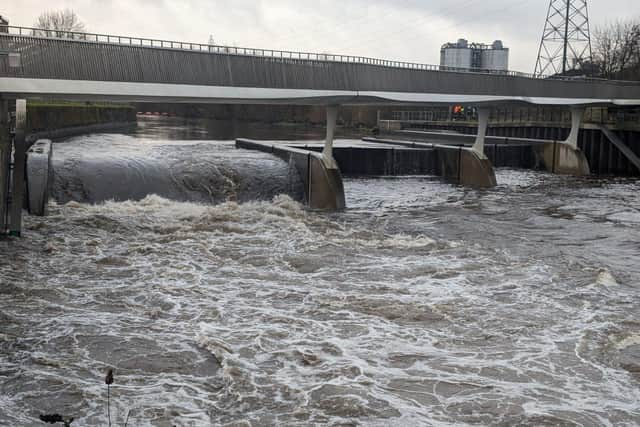Leeds Council urges residents to 'prepare for flooding' as storms and heavy rainfall activate defence scheme
and live on Freeview channel 276
Leeds City Council said the concentrated number of named storms and high rainfall, high winds and wintry conditions at the end of the year are a “cause for concern”.
Since July, the average monthly rainfall in Leeds has exceeded the national average of the last 30 years, with heavy rainfall in July, October and November.
Advertisement
Hide AdAdvertisement
Hide AdAn alphabetical list of named storms is released by the Met Office in September each year. The increased frequency of storms this autumn and winter means we are already at F, following Storms Elin and Fergus last weekend.


This is the fastest the UK has experienced this many named storms since the naming system was started in 2015, and conditions remain unsettled.
Storm clusters, a series of storms in quick succession, result in particularly challenging conditions, as the ground is still wet, and there is not sufficient time for river levels to decrease before the next period of heavy rainfall.
The council’s multi-million-pound Leeds Flood Alleviation Scheme Phase 1 (Leeds FAS1) was activated for the ninth time since its completion during Storm Babet, and was close to being needed again last weekend as storms Elin and Fergus made their way across the country.
Advertisement
Hide AdAdvertisement
Hide AdConstruction continues to progress on the Leeds Flood Alleviation Scheme Phase 2 (Leeds FAS2). Due to complete in Spring 2024, the scheme will protect a further 1,048 homes, 474 businesses and key infrastructure along a 14km stretch from Leeds City Station to Apperley Bridge.
When it is complete, the scheme will reduce the risk of flooding to a 0.5% chance of occurring in any given year, including a climate change allowance. The area currently protected by Leeds FAS1 will also have its level of protection doubled from a 1% chance to a 0.5% chance of flooding occurring in any given year.
Schemes to reduce flooding impacts from Meanwood Beck, Wortley Beck, Sheepscar Beck, Thorner Beck and in Potternewton are also under development.
Councillor Helen Hayden, the council’s executive member for sustainable development and infrastructure, said: “We have seen some important milestones on the Leeds Flood Alleviation Scheme this year, and I would like to thank everyone working on the scheme for their hard work, as well as all the landowners and residents who have worked with us to ensure that this state-of-the-art feat of engineering becomes a reality.
Advertisement
Hide AdAdvertisement
Hide Ad"It is a vital part of the plan to ensure that thousands of people and livelihoods in Leeds are more resilient to the increased threats of the climate emergency.”
“Many of us remember the events of Boxing Day 2015, and it is important to say that with the Leeds FAS1 fully operational, we are far more resilient to flooding than we were then.
"However, we have experienced a lot of rain this year, with more on the way – which further highlights the necessity of the work we continue to do on Leeds FAS2, as well as the other schemes across Leeds. It also serves as a prompt reminder that there are steps that we can all take to increase our own resilience should the worst happen. Please take the time to review the actions listed above so that you can be as prepared as possible.”
How to prepare for flooding
- Create a flood plan. You can find templates on the government website for a personal flood plan, community or group flood plan and a business flood plan
- Sign up for flood alerts in your area for free on gov.uk
- Read guidance on the different types of flood warnings, and what they mean for your home or your travel plans
- Do not try to travel through flood water, on foot, in a vehicle or otherwise. Read more advice for driving in storms, rain and strong wind
- Learn more about how you can report flooding, blocked drains and gullies, and more to the council and other relevant organisations